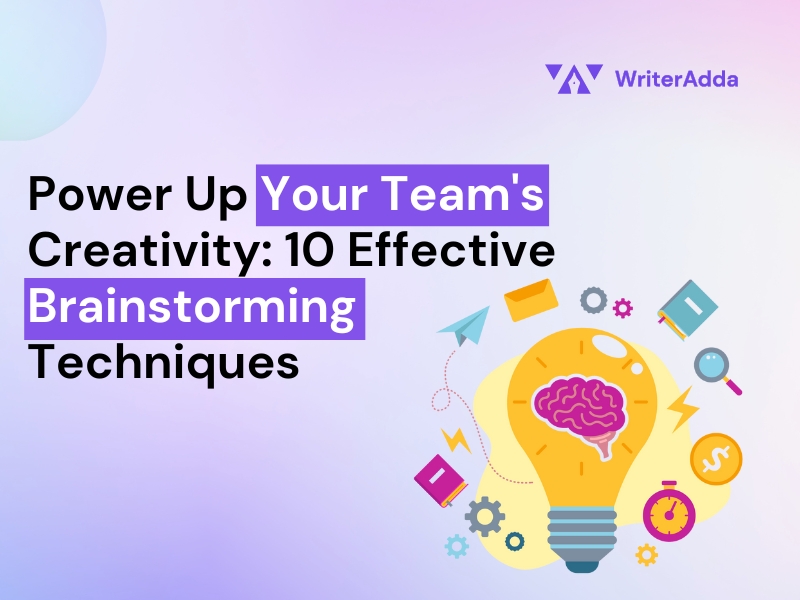We’re all familiar with classic brainstorming as a method for generating new ideas. However, the typical practice of bouncing ideas around a conference table can become dull and ineffective.
Bright thoughts do not come as simply as turning on a light. Brainstorming, the primary technique for generating many ideas, is essential to this creative process.
The team departs feeling inspired, accomplished, and eager for the next step. Effective brainstorming strategies for teams can help with this. Group brainstorming may encourage creative thinking, bring a team together, and help you develop the right idea.
This article introduces ten powerful techniques to boost creativity and engagement in your team’s brainstorming sessions, leading to innovative solutions.
What is brainstorming?
It is a method an individual or team uses to solve a problem or produce new ideas to enhance a product, company, or strategy.
Regardless of your favorite method, most brainstorming strategies for teams include three steps:
- Capture ideas.
- Discuss and criticize the concepts.
- Select which ideas to execute.
Every brainstorming process uses the same ingredients. All you need is a person or a team, a problem to solve, a chance to grab, and some time.
Types of Brainstorming
Asynchronous Brainstorming:
- Individuals contemplate a question or topic independently.
- Ideas are later shared and discussed in a shared document or platform.
- Advantages: It avoids groupthink and allows for individual reflection.
Synchronous Brainstorming:
- Team members gather for a collaborative brainstorming session.
- Ideas are collaboratively shared and promptly discussed, organized around specific themes.
- Advantages: Enables immediate collaboration and fosters idea building.
Hybrid Brainstorming:
- Combines elements of both asynchronous and synchronous brainstorming.
- Utilizes modern collaboration tools to facilitate discussion while allowing for independent creativity.
- Advantages: Capitalizes on individual reflection and group collaboration, mitigates groupthink.
Explore ten effective brainstorming techniques that will transform your next session.
As mentioned previously, brainstorming usually involves three key stages: idea generation, discussion and critique, and decision-making.
The following unique brainstorming methods will help you and your team through all three phases, whether in person or virtually.
Brainwriting
Participants jot down three ideas related to the topic in this brainstorming method within a set time frame. Papers are then passed around for others to build upon in person or through a digital platform like Slack for remote teams. This process continues until all ideas have circulated.
This effective brainstorming technique fosters balanced conversation and reduces the anchoring effect by allowing everyone to contribute and avoiding bias toward the initial ideas. As a result, it leads to more diverse and innovative solutions.
Rapid Ideation
Using the rapid ideation technique, participants scribble down as many ideas as possible in a predetermined amount of time without stopping to discuss or provide feedback. By avoiding hasty judgment and letting ideas flow, this method promotes creativity. Participants are encouraged to record ideas without self-censorship or second-guessing when there is a time constraint. This method solves the frequent issue of conventional brainstorming sessions: it encourages producing a wide diversity of ideas without restricting inventiveness.
The 5 Whys
The 5 Whys analysis, inspired by toddlers’ relentless questioning, is a straightforward yet unique brainstorming method for uncovering the root cause of problems. Originating from Toyota, it involves repeatedly asking “why” to delve deeper into the underlying issues. This approach fosters open discussion and can spark innovative solutions. Flowcharts and fishbone diagrams are useful tools for visualizing the progression of questions and answers in the 5 Whys analysis.
SCAMPER
SCAMPER is a valuable brainstorming method that encourages innovative thinking by questioning and exploring ideas from various angles:
- Substitute: Consider what would happen if you replaced one element with another.
- Combine: Explore the potential outcomes of merging different components.
- Adapt: Consider how your project could be adjusted to suit different contexts.
- Modify: Identify areas where changes could enhance the project’s value.
- Put to another use: Discover different applications or uses for your project.
- Eliminate: Consider what could be removed or simplified to streamline the project.
- Reverse: Reimagine the project’s organization or approach for greater effectiveness.
This method encourages thinking beyond conventional assumptions, allowing for innovative solutions and improvements. In marketing, S.C.A.M.P.E.R. can be applied to refine processes, optimize content, or develop more effective campaigns by exploring different approaches and potential changes.
Random Word Brainstorming
One of the primary purposes of a brainstorming session is to generate fresh ideas. One of the most effective ways to accomplish this is to say the first words that spring to mind when discussing a particular topic or subject. Random word brainstorming allows for just that.
The team is given a dilemma and must shout out the first words that come to mind, no matter what they are. These words are then written down and combined in intriguing ways to see if they result in a workable solution. This brainstorming technique is quick and typically quite effective at fixing a problem. The Random Words Brainstorming Template can help you get started. Using the Random Words Brainstorming Template can aid this effective brainstorming technique.
Starbursting
Complete independence without an ideation framework is not always the most effective way to generate and develop ideas. Structured procedures, such as Starbursting, can assist a team in generating more effective ideas and guarantee that all critical parts are considered early.
Start by sketching a six-pointed star on a sizable paper or an online whiteboard. Label each point of the star with the phrases: Who, What, Why, Where, When, and How. Invite the group to explore thoughts and questions on these topics.
At this point, the group should focus on brainstorming questions for each section without providing answers immediately. Moreover, generating follow-up questions can enhance the process of effectively developing ideas around your core concept or issue.
Round-robin brainstorming
During a round-robin brainstorming session, teams are split into smaller groups and responsible for devising solutions to challenges. As they move between groups, participants build on their peers’ suggestions and point out potential drawbacks. Finally, each group incorporates feedback to refine its initial proposal into a final concept. This structured approach encourages critical thinking, collaboration, and innovation within the team.
Reverse Brainstorming
A practice called reverse brainstorming involves purposefully creating roadblocks or issues rather than coming up with solutions. Proactive problem-solving assists in identifying potential dangers and weaknesses in a project or strategy. By starting with what not to do, reverse brainstorming streamlines the brainstorming process and prevents decision fatigue. In marketing, reverse brainstorming can anticipate campaign challenges, identify ineffective strategies, and redefine goals based on potential failures.
Mind Mapping
Mind mapping is a effective brainstorming technique for organizing ideas and encouraging creativity. Start by identifying the central task or problem and surround it with related terms or concepts. For instance, if addressing low website traffic, include terms like “organic traffic,” “SEO,” and “video strategy.” Then, add layers to each concept, outlining potential solutions or strategies. Continue expanding your mind map until you’ve thoroughly dissected the problem and generated creative solutions. This approach can breathe new life into seemingly mundane challenges and spark innovative ideas.
Brain-netting
Brain-netting has become a unique brainstorming method in the modern workplace, where virtual collaboration and distant teams are increasingly frequent. Email communication can be successful, but it can be time-consuming and overly professional.
Brain-netting involves participants using virtual collaboration software to debate ideas in real time before saving them to a cloud-based storage platform or within the collaboration program. Teams’ methods to virtual collaboration can differ. Team leaders may ask a general topic, such as “What do we want our customers to experience?” and have coworkers react, or teams may employ additional strategies discussed in this article, such as rolestorming, reverse brainstorming, and fast ideation.
Conclusion
While you may always hold a brainstorming session without adopting any brainstorming techniques, it does not give your team a sense of direction or an organized environment for creative thought.
However, using creative brainstorming techniques is fine.
Brainstorming approaches, which use techniques ranging from creativity to idea comparison, assist teams in finding solutions to the most difficult challenges.
Frequently Asked Questions
How does brainstorming help with writing?
Brainstorming generates diverse ideas and helps overcome writer's block. It facilitates idea organization and exploration of different perspectives.
Are there online tools for collaborative brainstorming?
Yes, platforms like Miro, Stormboard, and Google Jamboard enable real-time collaboration regardless of location.
What are brainstorming activities for team building and creativity?
Activities like "Two Truths and a Lie," "Role Reversal," and "The Six Thinking Hats" foster trust, collaboration, and creative thinking.
How can I encourage creative thinking in a brainstorming session?
Create a non-judgmental environment, welcome wild ideas, use creative prompts, and vary group dynamics to stimulate creativity.
How does creativity contribute to good brainstorming?
Creativity is essential for generating innovative ideas and solutions driving breakthrough concepts during brainstorming sessions.
What are the advantages of using brainstorming examples in business or creative contexts?
Brainstorming examples provide tangible illustrations, inspire participants, offer idea-generation frameworks, demonstrate practical applications, and serve as references for future sessions.




